The information gathered in a police interrogation room – sometimes called a secure interview room or hard interview room– during an interrogation of a suspect is not just investigative or probative – it is also evidence. As such, great care should be taken in how that information is collected. Police personnel may only have one chance to secure evidence gathered during an interrogation, and it must be able stand up in court. The layout of the interview room and audio/video recording devices are vital to legitimately securing evidence obtained during an interview.
Also tantamount to the collection of evidence through the interview is the safety and security of the people in the interrogation/interview room, including the suspect and interviewer, and of the other individuals inside the police facility. The level of security for an interrogation room will differ from that of a "soft" interview room -- also known as a witness/victim interview room, which is used for witnesses and other people not in custody. The layout and security measures for an interrogation room should not only prevent the suspect from leaving the room unauthorized, but should also prevent any unauthorized person from entering the interview room.
Number and Size
There should be at least three interrogation rooms in a police facility to allow for the simultaneous questioning of multiple individuals. Each room should be large enough for three people and the required furniture, but not so large that there is a lot of unutilized space. A large room with a lot of unnecessary open space could cause the interviewee to be less focused on the subject matter of the interview. A room that is 8 x 10 feet is preferable.
The interrogation rooms should be adjacent to the suspect processing area and be within the secure part of the facility. Transporting suspects into or through the main parts of the police station creates unnecessary security risks.
Walls
The walls of an interrogation room need to provide a high degree of soundproofing. It is important for privacy purposes that communications that take place within the room cannot be heard in adjacent rooms or in the hallway. For example, if two suspects are being questioned in two separate interview rooms and one suspect overhears the other interview, the integrity of both interviews could be compromised.
To maximize acoustical privacy, the room perimeter should have a Speech Privacy Potential (SPP) rating of 85. SPP is a measure of speech privacy between two spaces. A rating of 85 means that loud speech - even shouting - would not be audibly recognizable through the walls.
One way to achieve this high SPP rating is to construct the walls using solid core masonry blocks or blocks with concrete-filled cores. Additional soundproofing can be achieved with studs and two layers of gypsum board on one or both sides of the block wall, with sound attenuation insulation between the studs. The walls should run from the floor deck below to the underside of the deck above to prevent sounds from leaking out above the walls.
Another advantage of the high walls is to prevent someone from climbing over a potential void between the top of a low wall and the underside of the floor or roof deck above. The solid block construction also prevents escape through the wall, since holes in a gypsum board/drywall partition can be made relatively easily by kicking through it. Even the holes that ducts run through are potential places where an escape could occur. All ducts through the walls should have a security mesh inside to prevent a person from crawling out.
Doors
Doors need to be windowless and flush metal with solid cores. People walking by outside the room could be distracting to the interview if interrogation room doors had windows. It could also create problems if the suspect sees another suspect or witness related to the same crime walk by. In addition, the door should open outward in order to prevent the door being used as a weapon by any person within the room and to prevent anyone from blocking access into the room.
To help with soundproofing the room, provide sound gasketing all around the door, including an automatic door bottom. An automatic door bottom is a mechanical device that seals the gap between the door bottom and the floor when the door is closed to prevent sound transmission under the door. It automatically retracts when the door is opened.
There should be no lock on the inside of the door, eliminating the possibility of a person, whether it be the suspect or someone else, from locking the door from the inside and preventing authorized access. Door locks should be accessed from outside the room and should be controlled by a proximity card reader.
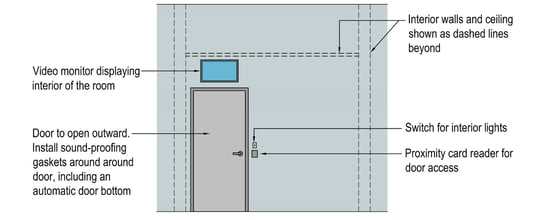
Interrogation Room Exterior View
Ceiling
A solid gypsum board ceiling is preferred to help prevent a suspect from crawling up into the ceiling. If a suspended ceiling is used, it should be the type that can have tamper-proof, lock-down tiles, not just to prevent escapes from the room through the ceiling, but to also prevent anyone from hiding contraband items above the ceiling. Whether a gypsum board or suspended ceiling is used, security mesh should be installed above the ceiling to provide greater protection from ceiling breaches.
As is the case with the walls, any duct work in the ceiling should be protected with security mesh inside the duct work.
Floors
Because of the nature of the interview room and the potential for unruly occupants of the room to create messes ranging from dirty shoes to spilled coffee to – let’s face it – bodily fluids such as vomit, a floor with a durable finish that is easy to clean is required. Vinyl tile is durable, but even with the best-intentioned cleaning schedule, dirt will accumulate between the tiles eventually. A preferred flooring is a seamless poured epoxy on concrete, including a continuous cove base, meaning there should be no sharp corner or seam between the base and the floor where dirt can get trapped. Provide a floor drain either in each interview room or in the hallway outside the rooms to aid in easier cleanup with a hose, mop, and broom.
Furniture
There should only be four pieces of furniture inside the interview room: a table, a chair for the interviewer, a chair for the observer, and a chair for the interviewee/suspect. The interviewer and observer chairs could be office-style chairs. The suspect’s chair must be bolted to the floor and include a cuff bar. Bolting the chair to the floor prevents it from being used as a weapon. However, don’t bolt the table to the floor; this would prevent police personnel from moving the table out of the way quickly in the case of an unruly suspect.
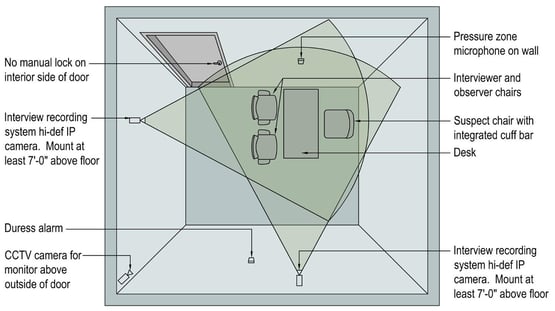
Interrogation Room Interior Floor Plan
Interview Recording Equipment
The collection of evidence occurs during the interview of a suspect. Therefore, it is imperative to have the proper recording equipment in place in the interview room. Two high-definition IP cameras should be provided in the room as part of the interview recording system to provide adequate coverage; one camera views the interviewee face-on and the second camera views the entire interview from the side. Mount the cameras high enough (at least 7 feet) so the face of the interviewee is not blocked by other people in the room. Place a high-quality microphone, such as a pressure zone microphone (also known as a boundary microphone) in an unobtrusive place in the room, such as on the wall. Pressure zone microphones work best when near a broad flat surface.
Since the interview recordings are considered evidence, the cameras and microphones are not integrated with any other CCTV security cameras within the facility and should not be viewable in the central security post of the police station. Instead, the video and audio from the interview room should be fed directly to digital recording equipment located in a separate room. This allows police personnel to observe the interview privately and without needing to be present in the interview room. The interviewer can also exit the room and leave the interviewee alone, but still have the interviewee monitored and observed by other police personnel.
It’s important to use a recording system dedicated to the collection of interrogation data, which should not be the same system used by the general security camera system. The general security camera system compresses the video and audio and could potentially make parts of a recorded interview difficult to clearly hear and see. Technology is always changing, but today’s police interview recording systems digitally record the interview in high fidelity onto a computer hard drive and can be transferred onto external storage devices, such as a DVD or flash drive.
Other Devices
Light switches and thermostat controls should be on the outside of the interview room so the suspect cannot tamper with them. There should be no clock visible to the suspect; that might serve only as a reminder of how long they have been there. All interview rooms should also be equipped with a duress alarm that can be pushed to report trouble to personnel outside the room.
A best practice is to have an officer stationed immediately outside the interview room while it is in use to monitor it for any emergency situations. Since there is no window on the interview room door, this can be achieved by providing a video monitor above the door connected to a CCTV camera inside. The camera and feed should be separate from the equipment recording the interview for evidence purposes, but it should also be integrated with the other security CCTV camera feeds monitored from the police facility’s central control post.
Alternative Ideas
Following the standards and practices for interview/interrogation rooms discussed in this blog will help in the safe and effective administration of suspect interviews. However, I have seen some alternative ideas that might have some merit.
Some feel that interrogation rooms should be designed with finishes that look more like an office and less spartan than traditional interview rooms. Under this alternative philosophy, softer finishes such as short-pile carpet and pastel colors are recommended. If the interview is shown in court, jurors might see the room as a non-threatening space that was less likely to lead to coercion of the suspect.
Some of these alternative room layout and design ideas could be taken into consideration by a police department, but it’s important to remember that the most important factors driving the design of the interrogation room are collecting interrogation evidence in a way that is compliant with court evidentiary standards and providing a safe and secure space for all involved parties.




.jpg)
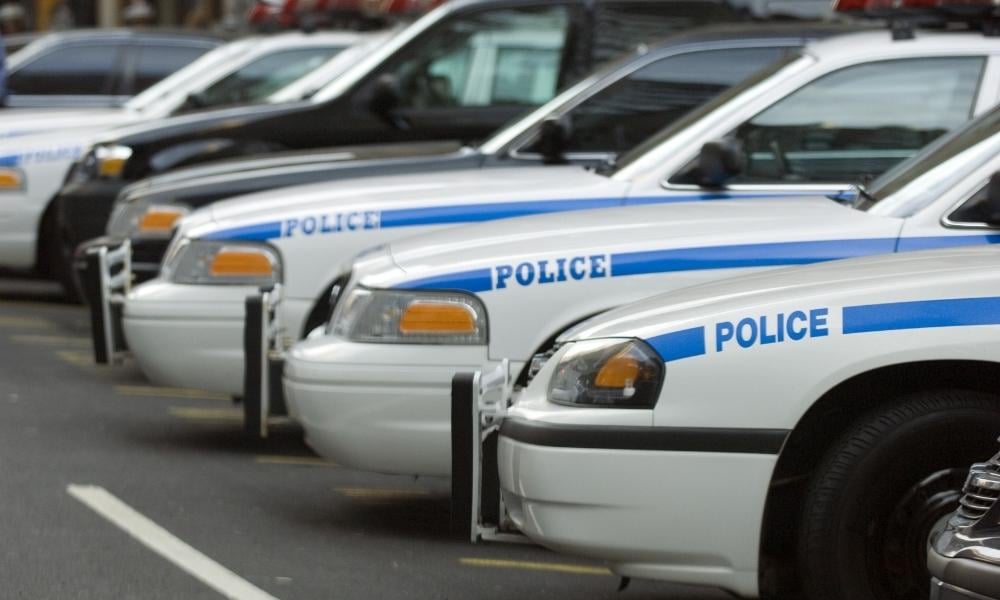
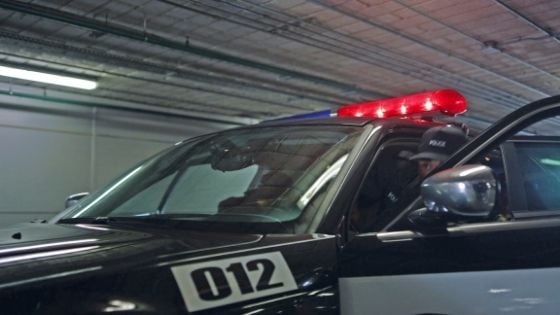
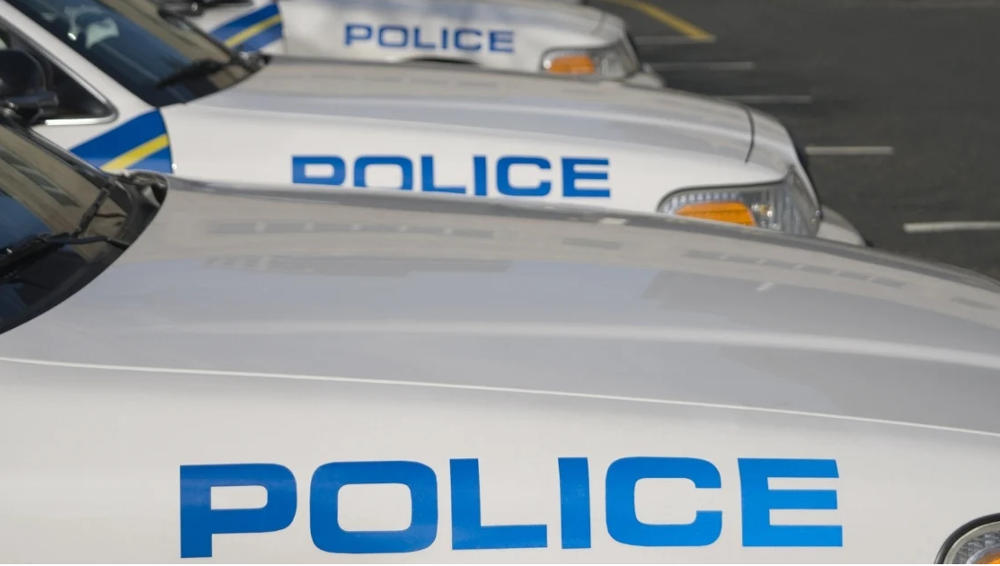
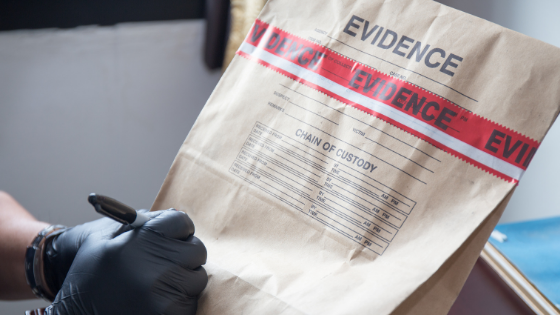
.jpg)

.jpg)
.jpg)
-1.jpg)
.jpg)
.jpg)
.jpg)
.jpg)
.jpg)

